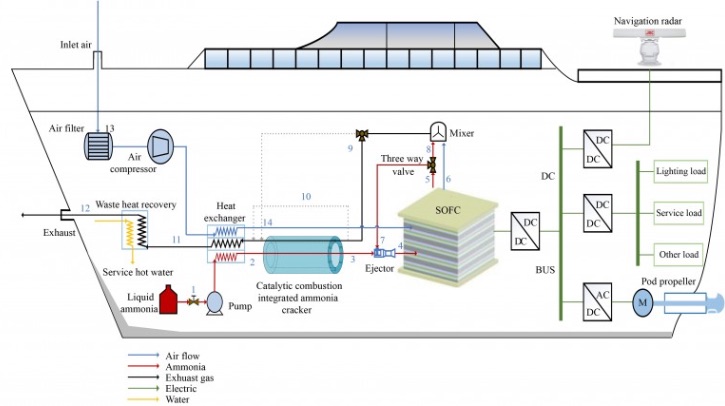Researchers from the China-UK Low Carbon College at Shanghai Jiao Tong University, in collaboration with the Energy Institute at University College London (UCL) and the School of Mechanical Engineering at Shanghai Jiao Tong University, have unveiled a solid oxide fuel cell (SOFC) system powered by ammonia (NH3) for all-electric ships.
Fuel cell prototyping
The study tackles the technical challenges of NH3 fuel SOFC ship power systems, including slow hydrogen production, low efficiency and limited space. The researchers have introduced a ribbed catalytic combustion-integrated ammonia cracker (IAC) for rapid hydrogen production, which is key for efficient NH3 decomposition into high-concentration H2. The system is designed to be adaptable to various sailing conditions and is validated using a 2kW prototype experimental rig.
The NH3-fueled SOFC system is designed for a target ship with a rated power of 96kW and an electrical efficiency of 60.13%, meeting the requirements for rated cruising conditions. The IAC, measuring 1.1m in length, achieves complete NH3 decomposition within 2.94 seconds, representing a 35% reduction in cracking time and a 42% decrease in required cabin space. The system’s efficiency can be further optimized by adjusting the circulation ratio (CR) and ammonia-oxygen ratio (A/O) under high-load voyage conditions, the researchers state.
Experimental results
The error for NH3 cracking H2 is less than 3% within the range of 570–700°C, which is relevant to typical ship operation scenarios. At 656°C, the NH3 cracking H2 rate reaches 100%. Under these conditions, the SOFC produces 2.045kW of power with an efficiency of approximately 58.66%. The noise level detected is 58.6dB, while the concentrations of CO2, NO and SO2 in the flue gas approach zero, demonstrating the system’s minimal environmental impact.
This research is expected to support the development of NH3-fueled SOFC power systems for ships.
In related news, Wärtsilä Gas Solutions and marine energy infrastructure company Höegh Evi recently completed development of what they state is the world’s first floating ammonia-to-hydrogen cracker. Read the full story here



